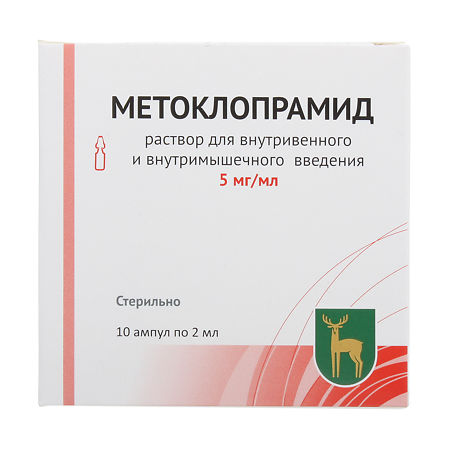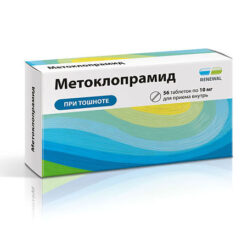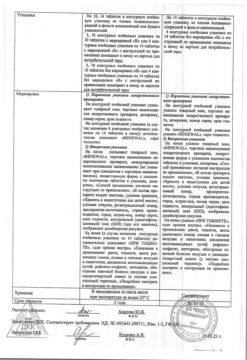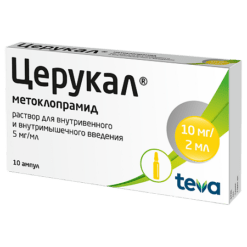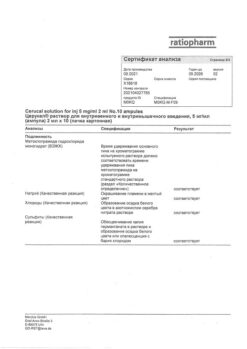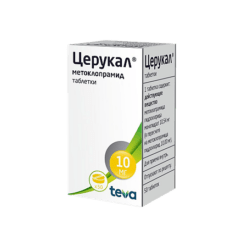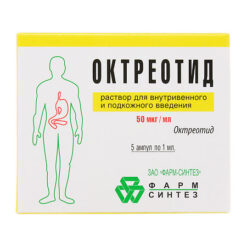No products in the cart.
Metoclopramide, 5 mg/ml 2 ml 10 pcs
€1.00
Out of stock
(E-mail when Stock is available)
Description
Metoclopramide is an antiemetic; it helps to reduce nausea, hiccups; it stimulates gastrointestinal peristalsis. Antiemetic effect is due to blockade of dopamine D2-receptors and increase threshold of trigger zone chemoreceptors; it is a blocker of serotonin receptors. < br>
It is believed that metoclopramide inhibits dopamine-induced relaxation of gastric smooth muscle, thereby increasing cholinergic responses of gastrointestinal smooth muscle. < br>
Promotes acceleration of gastric emptying by preventing relaxation of the gastric body and increasing activity of the antral stomach and upper small intestine. It reduces reflux of contents into the esophagus by increasing sphincter pressure of the esophagus at rest and increases clearance of acid from the esophagus by increasing the amplitude of its peristaltic contractions.
Methoclopramide stimulates prolactin secretion and causes a transient increase in circulating aldosterone levels, which may be accompanied by transient fluid retention.
Indications
Indications
⦠atony and hypotonia of the stomach and intestines (in particular, postoperative);
⦠biliary dyskinesia;
⦠reflux esophagitis;
⦠flatulence;
⦠in the treatment of exacerbations of gastric and duodenal ulcers;
⦠For strengthening peristalsis during gastrointestinal X-ray examinations.
Active ingredient
Active ingredient
Composition
Composition
1 ml of the solution contains:
The active ingredient:
metoclopramide hydrochloride 5 mg;
Associates:
dinatrium salt of ethylenediaminetetetraacetic acid;
sodium metabisulfite;
sodium acetate;
acetic acid glacial;
water for injection.
How to take, the dosage
How to take, the dosage
Interaction
Interaction
The effects of concomitant use with anticholinergic agents may be mutually attenuated.
Concomitant use with neuroleptics (especially phenothiazine series and butyrophenone derivatives) increases the risk of extrapyramidal reactions.
Concomitant use increases absorption of acetylsalicylic acid, paracetamol, ethanol.
Methoclopramide when administered by IV increases the rate of absorption of diazepam and increases its maximum plasma concentration.
Concomitant use with the slow-dissolving form of digoxin may decrease the serum concentration of digoxin by 1/3. When concomitant use with digoxin in liquid dosage form or as a rapidly soluble dosage form, no interaction has been noted.
In concomitant use with zopiclone absorption of zopiclone is accelerated; with cabergoline – possible decrease of cabergoline effectiveness; with ketoprofen – bioavailability of ketoprofen is decreased.
Because of antagonism to dopamine receptors, metoclopramide can decrease antiparkinsonian effect of levodopa, and bioavailability of levodopa may increase due to accelerated evacuation from the stomach under the influence of metoclopramide. The results of the interaction are equivocal.
Concomitant use with mexiletine results in faster absorption of mexiletine; with mefloquine – increased absorption rate of mefloquine and its concentration in plasma, while possible reduction of its side effects.
Concomitant use with morphine accelerates absorption of morphine when ingested and increases its sedative effect.
Concomitant use with nitrofurantoin decreases absorption of nitrofurantoin.
If metoclopramide is used immediately prior to the administration of propofol or thiopental, it may be necessary to reduce their induction doses.
In patients receiving metoclopramide, the effects of suxamethonium chloride are enhanced and prolonged.
Concomitant use with tolterodine decreases the effectiveness of metoclopramide; with fluvoxamine, there is a described case of extrapyramidal disorders; with fluoxetine, there is a risk of extrapyramidal disorders; with cyclosporine, the absorption of cyclosporine increases and its concentration in blood plasma increases.
Special Instructions
Special Instructions
With caution use in patients with bronchial asthma, arterial hypertension, hepatic and/or renal dysfunction, Parkinson’s disease.
Particular caution should be used in children, especially young children, because they have a significantly higher risk of dyskinetic syndrome. Metoclopramide may in some cases be effective in vomiting caused by taking cytostatics.
When used in elderly patients, it should be kept in mind that extrapyramidal disorders, especially parkinsonism and tardive dyskinesia, are the most common side effects with long-term use of metoclopramide in high or medium doses.
In the background of metoclopramide use, distortions of laboratory data of liver function and determination of plasma concentrations of aldosterone and prolactin are possible.
Impact on the ability to drive and operate machinery
Potentially dangerous activities requiring increased attention and quick psychomotor reactions should be avoided during treatment.
Contraindications
Contraindications
Side effects
Side effects
Digestive system disorders: at the beginning of treatment constipation, diarrhea are possible; rarely – dry mouth.
CNS disorders: at the beginning of treatment fatigue, drowsiness, dizziness, headache, depression, akathisia are possible.
Extrapyramid symptoms may occur in children and young patients (even after single use of metoclopramide): facial spasm, hyperkinesias, spastic torticollis (as a rule, they disappear immediately after discontinuation of metoclopramide).
Parkinsonism and dyskinesia may occur with long-term use, often in elderly patients.
Hematopoietic system disorders: at the beginning of treatment agranulocytosis is possible.
Endocrine system disorders: rarely, with prolonged use in high doses – galactorrhea, gynecomastia, menstrual disorders.
Allergic reactions: rare – skin rash.
Similarities
Similarities
Additional information
| Manufacturer | Moscow Endocrine Plant, Russia |
|---|---|
| Medication form | solution |
| Brand | Moscow Endocrine Plant |
Other forms…
Related products
Buy Metoclopramide, 5 mg/ml 2 ml 10 pcs with delivery to USA, UK, Europe and over 120 other countries.

